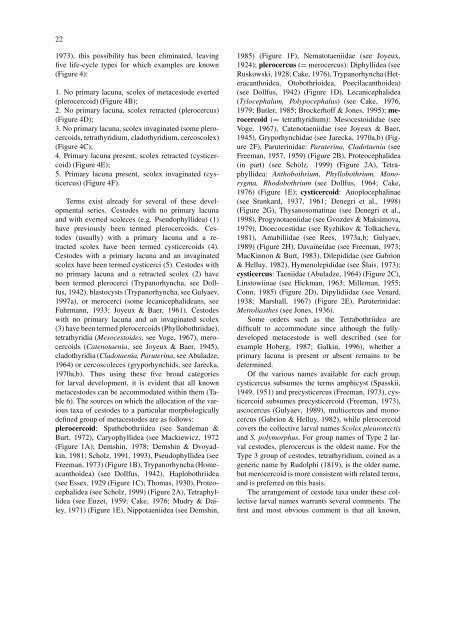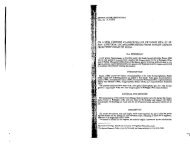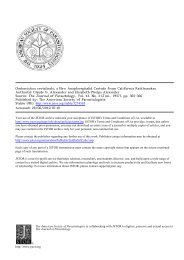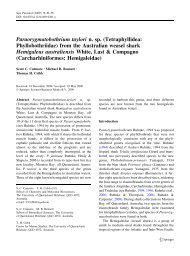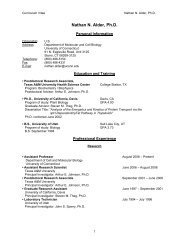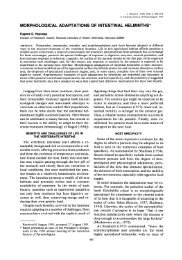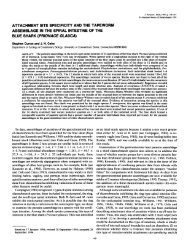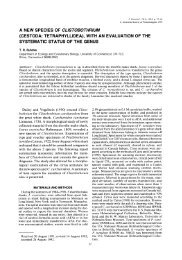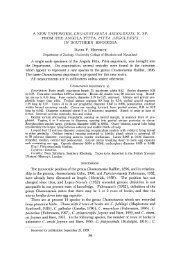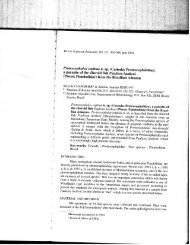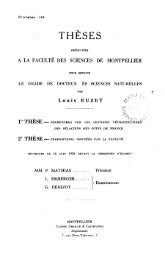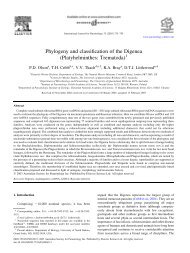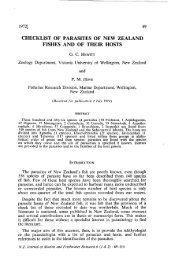The terminology of larval cestodes or metacestodes
The terminology of larval cestodes or metacestodes
The terminology of larval cestodes or metacestodes
You also want an ePaper? Increase the reach of your titles
YUMPU automatically turns print PDFs into web optimized ePapers that Google loves.
221973), this possibility has been eliminated, leavingfive life-cycle types f<strong>or</strong> which examples are known(Figure 4):1. No primary lacuna, scolex <strong>of</strong> metacestode everted(plerocercoid) (Figure 4B);2. No primary lacuna, scolex retracted (plerocercus)(Figure 4D);3. No primary lacuna, scolex invaginated (some plerocercoids,tetrathyridium, cladothyridium, cercoscolex)(Figure 4C);4. Primary lacuna present, scolex retracted (cysticercoid)(Figure 4E);5. Primary lacuna present, scolex invaginated (cysticercus)(Figure 4F).Terms exist already f<strong>or</strong> several <strong>of</strong> these developmentalseries. Cestodes with no primary lacunaand with everted scoleces (e.g. Pseudophyllidea) (1)have previously been termed plerocercoids. Cestodes(usually) with a primary lacuna and a retractedscolex have been termed cysticercoids (4).Cestodes with a primary lacuna and an invaginatedscolex have been termed cysticerci (5). Cestodes withno primary lacuna and a retracted scolex (2) havebeen termed plerocerci (Trypan<strong>or</strong>hyncha, see Dollfus,1942), blastocysts (Trypan<strong>or</strong>hyncha, see Gulyaev,1997a), <strong>or</strong> merocerci (some lecanicephalideans, seeFuhrmann, 1933; Joyeux & Baer, 1961). Cestodeswith no primary lacuna and an invaginated scolex(3) have been termed plerocercoids (Phyllobothriidae),tetrathyridia (Mesocestoides, see Voge, 1967), merocercoids(Catenotaenia, see Joyeux & Baer, 1945),cladothyridia (Cladotaenia, Paruterina, see Abuladze,1964) <strong>or</strong> cercoscoleces (gryp<strong>or</strong>hynchids, see Jarecka,1970a,b). Thus using these five broad categ<strong>or</strong>iesf<strong>or</strong> <strong>larval</strong> development, it is evident that all knownmeta<strong>cestodes</strong> can be accommodated within them (Table6). <strong>The</strong> sources on which the allocation <strong>of</strong> the varioustaxa <strong>of</strong> <strong>cestodes</strong> to a particular m<strong>or</strong>phologicallydefined group <strong>of</strong> meta<strong>cestodes</strong> are as follows:plerocercoid: Spathebothriidea (see Sandeman &Burt, 1972), Caryophyllidea (see Mackiewicz, 1972(Figure 1A); Demshin, 1978; Demshin & Dvoyadkin,1981; Scholz, 1991, 1993), Pseudophyllidea (seeFreeman, 1973) (Figure 1B), Trypan<strong>or</strong>hyncha (Homeacanthoidea)(see Dollfus, 1942), Haplobothriidea(see Essex, 1929 (Figure 1C); Thomas, 1930), Proteocephalidea(see Scholz, 1999) (Figure 2A), Tetraphyllidea(see Euzet, 1959; Cake, 1976; Mudry & Dailey,1971) (Figure 1E), Nippotaeniidea (see Demshin,1985) (Figure 1F), Nematotaeniidae (see Joyeux,1924); plerocercus (= merocercus): Diphyllidea (seeRuskowski, 1928; Cake, 1976), Trypan<strong>or</strong>hyncha (Heteracanthoidea,Otobothrioidea, Poecilacanthoidea)(see Dollfus, 1942) (Figure 1D), Lecanicephalidea(Tylocephalum, Polypocephalus) (see Cake, 1976,1979; Butler, 1985; Brockerh<strong>of</strong>f & Jones, 1995); merocercoid(= tetrathyridium): Mesocestoididae (seeVoge, 1967), Catenotaeniidae (see Joyeux & Baer,1945), Gryp<strong>or</strong>hynchidae (see Jarecka, 1970a,b) (Figure2F), Paruterinidae: Paruterina, Cladotaenia (seeFreeman, 1957, 1959) (Figure 2B), Proteocephalidea(in part) (see Scholz, 1999) (Figure 2A), Tetraphyllidea:Anthobothrium, Phyllobothrium, Mon<strong>or</strong>ygma,Rhodobothrium (see Dollfus, 1964; Cake,1976) (Figure 1E); cysticercoid: Anoplocephalinae(see Stunkard, 1937, 1961; Denegri et al., 1998)(Figure 2G), Thysanosomatinae (see Denegri et al.,1998), Progynotaeniidae (see Gvozdev & Maksimova,1979), Dioecocestidae (see Ryzhikov & Tolkacheva,1981), Amabiliidae (see Rees, 1973a,b; Gulyaev,1989) (Figure 2H), Davaineidae (see Freeman, 1973;MacKinnon & Burt, 1983), Dilepididae (see Gabrion& Helluy, 1982), Hymenolepididae (see Šlais, 1973);cysticercus: Taeniidae (Abuladze, 1964) (Figure 2C),Linstowiinae (see Hickman, 1963; Milleman, 1955;Conn, 1985) (Figure 2D), Dipylidiidae (see Venard,1938; Marshall, 1967) (Figure 2E), Paruterinidae:Metroliasthes (see Jones, 1936).Some <strong>or</strong>ders such as the Tetrabothriidea aredifficult to accommodate since although the fullydevelopedmetacestode is well described (see f<strong>or</strong>example Hoberg, 1987; Galkin, 1996), whether aprimary lacuna is present <strong>or</strong> absent remains to bedetermined.Of the various names available f<strong>or</strong> each group,cysticercus subsumes the terms amphicyst (Spasskii,1949, 1951) and precysticercus (Freeman, 1973), cysticercoidsubsumes precysticercoid (Freeman, 1973),ascocercus (Gulyaev, 1989), multicercus and monocercus(Gabrion & Helluy, 1982), while plerocercoidcovers the collective <strong>larval</strong> names Scolex pleuronectisand S. polym<strong>or</strong>phus. F<strong>or</strong> group names <strong>of</strong> Type 2 <strong>larval</strong><strong>cestodes</strong>, plerocercus is the oldest name. F<strong>or</strong> theType 3 group <strong>of</strong> <strong>cestodes</strong>, tetrathyridium, coined as ageneric name by Rudolphi (1819), is the older name,but merocercoid is m<strong>or</strong>e consistent with related terms,and is preferred on this basis.<strong>The</strong> arrangement <strong>of</strong> cestode taxa under these collective<strong>larval</strong> names warrants several comments. <strong>The</strong>first and most obvious comment is that all known,


